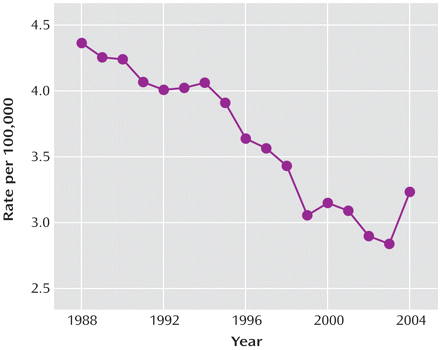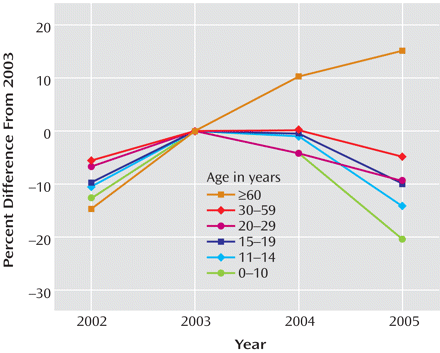Archived Content
The National Institute of Mental Health archives materials that are over 4 years old and no longer being updated. The content on this page is provided for historical reference purposes only and may not reflect current knowledge or information.
Drops in SSRI prescription rates may coincide with increases in youth suicides
• Science Update
A 2004 spike in suicide rates may have coincided with a drop in antidepressant prescriptions for youth, following warnings from U.S and European regulatory agencies that the medications might trigger suicidal thoughts.
NIMH grantees Robert Gibbons, Ph.D., University of Illinois at Chicago and J. John Mann, M.D., Columbia University, and colleagues, make a case for a possible link between changes in prescription patterns, regulatory warnings and suicide rates in the September, 2007 issue of the American Journal of Psychiatry.
Concerned that decreased use of antidepressants could potentially have a negative public health impact, they predicted more increases in suicides if current trends continue. However, they based much of their analysis on data from the Netherlands, since U.S. suicide rates for 2005 won’t be available until later this year.
The researchers reported that SSRI (serotonin selective reuptake inhibitor) prescriptions for youth dropped by 22 percent in both the U.S. and the Netherlands during 2003-2004. In the Netherlands, youth suicides increased by 49 percent during 2003-2005. In the U.S., such rates increased by 14 percent in 2004 – the largest change since data collection began in l979.
The pattern of decreasing SSRI prescription rates coinciding with increasing suicide rates held regardless of age. In general, the older the age group, the less prescription rates dropped, up to age 60. For adults over 60, for whom antidepressant prescription rates continued to rise, suicide rates reached a record low in 2004.
In the fall of 2004, following months of public hearings and preliminary warnings linking antidepressants with increased risk of suicidal thinking, the U.S. Food and Drug Administration (FDA) decided to require a black box warning on antidepressants for youth, which was implemented in 2005. The FDA recommended in 2007 that the warnings be extended to young adults up to age 24.
Based on mathematical models using previous years’ data, the authors predicted an 18 percent increase in youth suicides between 2003 and 2005 (Actual U.S. 2005 suicide rates will be released in December, 2007.). In addition, if extending the warning to adults results in a 20 percent decrease in SSRI prescriptions, they project a 10 percent increase in adult suicides within one year. In lieu of the warnings, they recommended better training for doctors.

Youth suicide rate (ages 5-19) in the U.S. increased conspicuously in 2004.

SSRI prescription rates in the U.S. declined during 2004-2005 (except for the 60 and over group), with younger groups showing the steepest drop. Data expressed as a percentage of the 2003 rate.
